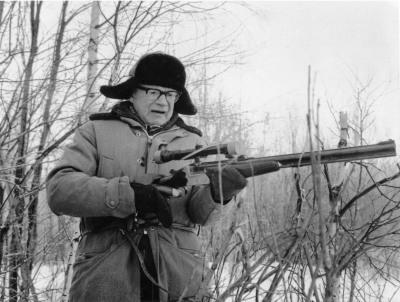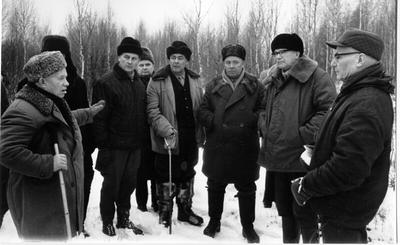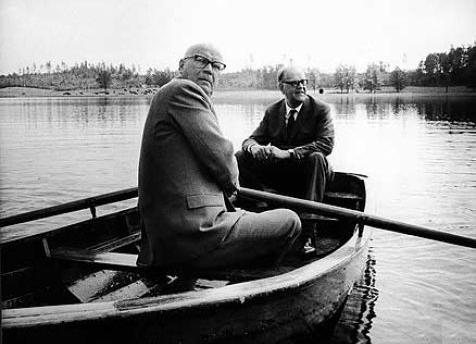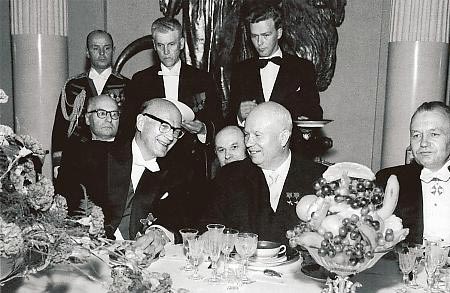<Back to Index>
- 8th President of Finland Urho Kaleva Kekkonen, 1900
PAGE SPONSOR
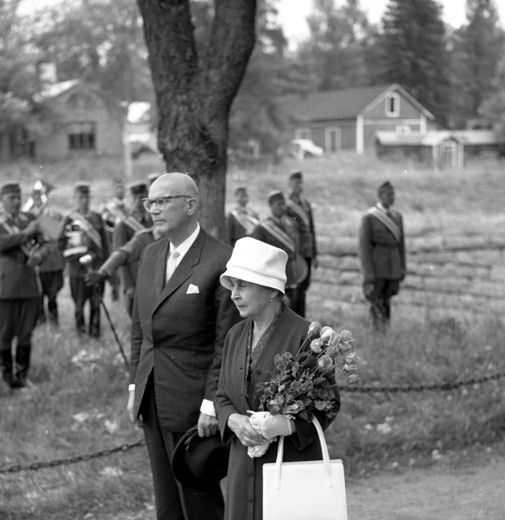
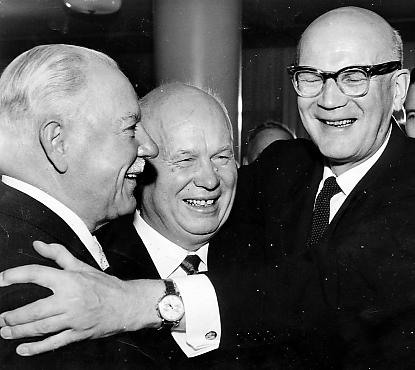
Urho Kaleva Kekkonen (3 September 1900 - 31 August 1986), was a Finnish politician who served as Prime Minister of Finland (1950 – 1953, 1954 – 1956) and later as the eighth President of Finland (1956 – 1982). Kekkonen continued the “active neutrality” policy of his predecessor President Juho Kusti Paasikivi, a doctrine which came to be known as the “Paasikivi – Kekkonen line”. Under it, Finland retained its independence while being able to trade with both NATO members and those of the Warsaw Pact. Kekkonen was the longest serving President of Finland.
The son of Juho Kekkonen and Emilia Pylvänäinen, Kekkonen was born in Pielavesi, in the Savo region of Finland and spent his childhood in Kainuu. His family were farmers (though not poor tenant farmers, as some of his supporters later claimed). His father was originally a farm hand and forestry worker who rose to become a forestry manager and stock agent at Halla Ltd. Claims made that Kekkonen's family had lived in a rudimentary farmhouse with no chimney were later proved to be false — a photograph of Kekkonen's childhood home had been retouched to remove the chimney. His school years did not go smoothly. During the Finnish Civil War, Kekkonen fought for the White Guard (Kajaani chapter), fighting in Kuopio, Varkaus, Mouhu and Viipuri, and taking part in mop-up operations, including leading a firing squad in Hamina. He later admitted to having killed a man in battle, but wrote in his memoirs that he was randomly selected by his company commander to follow a squad escorting ten prisoners, where the squad turned out to be a firing squad, and then to give the actual order to aim and fire.
In independent Finland, Kekkonen first worked as a journalist in Kajaani then moved to Helsinki in 1921 to study law. While studying he worked for the security police EK between 1921 and 1927, where he became acquainted with anti - Communist policing. During this time he also met his future wife, Sylvi Salome Uino (1900 – 1974), a typist at the police station. They had two sons, Matti (born 1928) and Taneli (1928 – 1985). Matti Kekkonen served as a Center Party member of Parliament from 1958 to 1969.
In
1927, Kekkonen became a lawyer and worked for the Association of Rural
Municipalities but was forced to resign in 1932 after making abrasive
comments. Kekkonen took a Doctor of Laws degree in 1936 at the University of Helsinki where he was active in the Northern Ostrobothnian student nation and editor - in - chief of the student newspaper Ylioppilaslehti in
the period 1927 – 1928. He was also an athlete whose greatest achievement
was to become Finnish high jump champion in 1924 with a jump of 1.85
metres (6 ft 1 in). He was best at the standing jump.
A nationalist at heart, Kekkonen's ideological roots lay in the student politics of newly independent Finland and in the radicalism of the right wing. He joined the Academic Karelia Society (Akateeminen Karjala - Seura), an organization favoring Finland's annexation of East Karelia, but resigned from it in 1932 along with over 100 other moderate members because of the organization's support for the 1932 far right Mäntsälä rebellion. According to Johannes Virolainen, a longtime Agrarian and Centrist politician, some Finnish right wingers hated and mocked Kekkonen for the decision and cast him as a power hungry opportunist. Kekkonen chaired Suomalaisuuden Liitto, another nationalist organization, from 1930 to 1932. In 1933, Kekkonen joined the Agrarian League (later renamed the Center Party) and in the same year also became a civil servant at the Ministry of Agriculture. During his time there Kekkonen made his first unsuccessful attempt at getting elected to the Finnish Parliament.
Kekkonen successfully stood for parliament a second time in 1936 whereupon he became Justice Minister, serving from 1936 to 1937. During his term, he enacted the "Tricks of Kekkonen" (Kekkosen konstit), an attempt to ban the right wing radical Patriotic People's Movement (Isänmaallinen Kansanliike, IKL). In the end this effort was found illegal and halted by the Supreme Court. Kekkonen was also Minister of the Interior from 1937 to 1939.
He was not a member of the cabinets during the Winter War or the Continuation War and was the sole Member of Parliament to vote against the Moscow peace treaty in March 1940. During the Continuation War, Kekkonen served as director of the Karelian Evacuees' Welfare Center from 1940 to 1943 and as the Ministry of Finance's commissioner for coordination from 1943 to 1945, tasked with rationalizing public administration. By that time, he had become one of the leading politicians within the so-called Peace opposition. In 1944, he again became Minister of Justice, serving until 1946, and had to deal with the war responsibility trials. Kekkonen was a Deputy Speaker of the Parliament 1946 – 1947, and was Speaker from 1948 to 1950.
In
the 1950 Presidential election, Kekkonen was the candidate of the
Agrarian Party. He conducted a vigorous campaign against incumbent
President Juho Kusti Paasikivi to finish third in the first and only
ballot, receiving 62 votes in the electoral college, while Paasikivi was re-elected with 171. After the election, Paasikivi appointed Kekkonen Prime Minister where in all his five cabinets, he emphasized the need to maintain friendly relations with the Soviet Union. Known for his authoritarian personality, he was ousted in 1953 but returned as Prime Minister from 1954 to 1956. Kekkonen also served as Minister of Foreign Affairs for periods in 1952 – 1953 and 1954 concurrent with his prime ministership.
During Kekkonen's term, the balance of power between the Finnish Council of State and the President tilted heavily towards the President. In principle and formally, parliamentarism was followed with governments nominated by a parliamentary majority. However, Kekkonen era cabinets were often in bitter internal disagreement and alliances formed broke down easily. New cabinets often tried to reverse their predecessors' policies. Kekkonen used his power extensively to nominate ministers and railroaded new government compositions through the parliamentary process. Publicly and with impunity, he also used the old boy network to bypass the government and communicate directly with high officials. Only when Kekkonen's term ended did governments remain stable throughout the entire period between elections. Nevertheless, during Kekkonen's presidency, a few parties were represented in most governments — mainly the Centrists, Social Democrats and Swedish People's Party — while the People's Democrats and Communists were often in government from 1966 onwards.
Throughout
his time as president, Kekkonen did his best to keep political
adversaries in check. The Center Party's rival National Coalition Party
was kept in opposition for 20 years despite good election performances.
The Rural Party (which
had broken away from the Center Party) was treated similarly. On a few
occasions, parliament was dissolved if its political composition did not
please Kekkonen. Despite his career in the Center Party, his relation
to the party was often difficult. Too prominent Center Party members
often found themselves sidelined, as Kekkonen negotiated directly with
the lower level. Chairman of the Center Party, Johannes Virolainen, was
threatened by Kekkonen with dissolution of parliament when Kekkonen
wanted to nominate SDP's Sorsa instead of Virolainen as Prime Minister. The
so called "Mill Letters" of Kekkonen were a continuous stream of
directives to high officials, politicians, journalists and others.
Nevertheless, Kekkonen did not use coercive measures while some
prominent politicians, most notably Tuure Junnila (NCP) and Veikko Vennamo (Rural Party), "branded" themselves as "anti - Kekkonen".
In the presidential election of 1956, Kekkonen defeated the Social Democrat Karl - August Fagerholm 151 – 149 in the electoral college vote. The campaign was notably vicious, with many personal attacks against several candidates, especially Kekkonen. The tabloid gossip newspaper Sensaatio - Uutiset ("Sensational News") accused Kekkonen of fist fighting, excessive drinking and extramarital affairs. The drinking and womanizing charges were partly true. At times, during evening parties with his friends, Kekkonen got drunk, and he had at least two longtime mistresses. As president, Kekkonen continued the neutrality policy of President Paasikivi, which came to be known as the Paasikivi - Kekkonen line. From the beginning he ruled with the assumption that he alone was acceptable to the Soviet Union as Finnish President. Evidence from defectors like Oleg Gordievsky and files from the Soviet archives show that keeping Kekkonen in power was indeed the main objective of the Soviet Union in its relations with Finland.
In August 1958, Karl - August Fagerholm's third cabinet, a coalition government led by the Social Democratic Party (SDP) and including Kekkonen's party Agrarian League, was formed. The Communist front SKDL was left out. This irritated the Soviet Union because of the inclusion of ministers from SDP's anti - Communist wing, namely Väinö Leskinen and Olavi Lindblom. Kekkonen had warned against this, but was ignored by SDP. The crisis, called "night frost" by Nikita Khrushchev, led to Soviet pressure against Finland in economic matters. Kekkonen sided with the Soviet Union, working behind the scenes against the cabinet, and indeed, Fagerholm's cabinet resigned in December 1958. The Finnish Foreign Ministry ignored United States offers for help as promised by Ambassador Hubert Humphrey in November 1958. The crisis was resolved by Kekkonen in January 1959, when he privately traveled to Moscow to negotiate with Khrushchev and Andrei Gromyko. The crisis hurt the freedom of the parties to compose coalition governments, so that after the crisis, Kekkonen was seen as the only authority for deciding which parties can participate in cabinets.
The second time the Soviets helped Kekkonen came in the Note Crisis in 1961. The most widely held view of the Note Crisis is that the Soviet Union's motivation was to ensure Kekkonen's re-election. Kekkonen had planned to prevent the parties from forming an anti - Kekkonen alliance to promote Olavi Honka in the 1962 presidential elections by dissolving parliament. However, in October 1961, the Soviet Union sent a diplomatic note demanding common "military exercises" against the West in reference to the FCMA treaty, in effect a threat to occupy the country. As a result, Honka dropped his candidacy, leaving Kekkonen with a clear majority (199 / 300 electors) in the 1962 elections. In addition to support from his own party, Kekkonen received the backing of the Swedish People's Party and the Finnish People's Party, a small classical liberal party. Furthermore, the Conservative National Coalition Party quietly supported Kekkonen, although they had no official presidential candidate after Honka's withdrawal. Following the Note Crisis, genuine opposition to Kekkonen disappeared, and he acquired an exceptionally strong — later even autocratic — status as the political leader of Finland.
Kekkonen's policies, especially towards the USSR, were criticized within his own party by Veikko Vennamo, who broke off his Center Party affiliation when Kekkonen was elected president in 1956. In 1959, Vennamo founded the Finnish Rural Party, the forerunner of the nationalist True Finns.
In the 1960s Kekkonen was responsible for a number of foreign policy initiatives, including the Nordic nuclear free zone proposal,
a border agreement with Norway and a 1969 Conference on Security and
Cooperation in Europe. The purpose of these initiatives was to avoid the
enforcement of the military articles in the FCMA treaty which called
for military co-operation with Russia, thereby strengthening Finland's
attempts to implement a policy of neutrality. Following the invasion of Czechoslovakia in
1968, pressure for neutrality increased. Kekkonen informed the Soviet
Union in 1970 that if it was no longer prepared to recognize Finland's
neutrality, he would not continue as president, nor would the FCMA
treaty be extended.
Kekkonen was re-elected for a third term in 1968. That year, he was supported by five political parties: the Center Party, the Social Democrats, the Social Democratic Union of Workers and Smallholders (a short lived SDP faction), the Finnish People's Democratic League (a communist front), and the Swedish People's Party. He received 201 votes in the electoral college, whereas the National Coalition party's candidate finished second with 66 votes. Vennamo came third with 33 votes. Although Kekkonen was re-elected with two - thirds of the vote, he was so displeased with his opponents and their behavior that he publicly refused to stand for the presidency again. Vennamo's bold and constant criticisms of his presidency and policies especially infuriated Kekkonen, who labelled him a "cheat" and "demagogue".
Initially Kekkonen had intended to retire at the end of this term, and the Center Party already began to prepare his succession by Ahti Karjalainen. However, Kekkonen began to see Karjalainen as a rival instead, and eventually rejected the idea.
In
1973, the enaction of an emergency law saw his presidency extended by
four years. By this time, Kekkonen had secured the backing of most
political parties, but the major right wing National Coalition Party,
which Kekkonen had opposed, was still skeptical, and stood in the way
of the required 5/6 majority. Concurrently, Finland was negotiating a
free trade agreement with the EEC,
and as the EEC agreement promoted economic integration with the West,
it was supported by NCP. Kekkonen had implied that if he was not remain
president, the Soviets would not accept Finland's free trade agreement
with the EEC. The tactic secured National Coalition support and the subsequent passing of an emergency law. The elimination of any significant opposition and competition meant he became Finland's de facto political autocrat. His power reached its zenith in 1975 when he dissolved parliament and hosted the Conference on Security and Co-operation in Europe (CSCE) in Helsinki with the assistance of a caretaker government.
After nine political parties blindly supported Kekkonen's candidacy in the 1978 Presidential election, including the Social Democratic, Center and National Coalition parties, no serious rivals remained. He humiliated his opponents by not appearing in televised presidential debates and went on to win 259 out of the 300 electoral college votes, with his nearest rival, Raino Westerholm of the Christian Union, receiving only 25.
According
to Finnish historians and political journalists, there were at least
three reasons that Kekkonen clung on to the Presidency. Firstly, he did
not believe that any of his successor candidates would manage Finland's
Soviet foreign policy well enough. Secondly, until at least the summer
of 1978, he considered there was room for improvement in Finnish - Soviet
relations and that his experience was vital to the process. This is
exemplified by the use of his diplomatic skills to reject the Soviet Defense Minister Dmitriy Ustinov's
offer of closer military co-operation. Thirdly, he maintained that by
working for as long as possible he would remain healthy and live longer. Kekkonen's most severe critics, such as Veikko Vennamo, claimed that he remained President so long mainly because he and his closest associates were power hungry. In 1979 Urho Kekkonen was awarded the Lenin Peace Prize.
From December 1980 onwards, Kekkonen suffered from an undisclosed disease that appeared to affect his brain functions, sometimes leading to delusional thoughts. He had begun to suffer occasional brief memory lapses as early as the autumn of 1972, which became more frequent during the late 1970s. Around the same time, Kekkonen's eyesight deteriorated so much that for his last few years in office, all of his official papers had to be typed in block letters. Kekkonen had also suffered from a failing sense of balance since the mid 1970s and from enlargement of his prostate gland since 1974. He was also subject to occasional violent headaches and suffered from diabetes from the autumn of 1979.
According to biographer Juhani Suomi, Kekkonen gave no thought to resigning until his physical condition began to decline in July 1981. The 80 year old President then began to seriously consider resigning, most likely in early 1982. Prime Minister Mauno Koivisto finally defeated Kekkonen in 1981. In April, Koivisto had done what no one else had dared to during Kekkonen's presidency by stating that under the constitution, the prime minister and cabinet were responsible to Parliament not to the President. He then refused to resign at Kekkonen's request. Historians and journalists debate the precise meaning of this dispute.
According to Seppo Zetterberg, Allan Tiitta and Pekka Hyvärinen, Kekkonen wanted to force Koivisto to resign to decrease his chances of succeeding him as President. In contrast, Juhani Suomi, believed the dispute was about the scheming between prospective presidential candidates, such as Koivisto. Kekkonen at times criticized Koivisto for making political decisions too slowly and for his vacillation, especially for speaking too unclearly and philosophically. This is generally seen as the death - knell of the Kekkonen era.
Kekkonen became ill in August during a fishing trip to Iceland. He went on medical leave on 10 September, before finally resigning due to ill health on 26 October 1981, aged 81. There is no report available about his illness, as the papers have been moved to an unknown location, but it is commonly believed that he suffered from vascular dementia, probably due to atherosclerosis.
Kekkonen died at Tamminiemi in
1986, three days short of his 86th birthday, and was buried with full
honors. His heirs restricted access to his diaries and later an
"authorized" biography by Juhani Suomi was
commissioned, the author subsequently defending the interpretation of
the history therein and denigrating most other interpretations.
Some of Kekkonen's actions remain controversial in modern Finland. He often used what was termed the "Moscow card" when his authority was threatened, but he was not the only Finnish politician with close relations to Soviet representatives. Kekkonen's authoritarian behavior during his presidential term was one of the main reasons for the reforms of the Finnish Constitution in 1984 – 2003. Under these, the powers of Parliament and the Prime Minister were increased at the expense of Presidential power. Several of the changes were initiated by Kekkonen's successors.
- Presidential terms were limited to two consecutive ones.
- The President's role in cabinet formation was restricted.
- The President was to be elected directly, not by an electoral college.
- The President could no longer dissolve Parliament without the support of the Prime Minister.
- The Prime Minister's role in shaping the foreign relations of Finland was enhanced.
Kekkonen was largely responsible for Finlandization, a policy that allowed the Soviet Union to exert power over the country. The policy spanned his whole presidency with human rights violations associated with Finlandization carried out on the orders of Kekkonen. For example, he insisted that all Soviet defectors who managed to escape across the border to Finland were to be forcibly repatriated.
Although
controversial, his policy of neutrality allowed trade with both the
Communist and Western blocs. The bilateral trade policy with the Soviet
Union was lucrative for many Finnish businesses. His term saw a period
of extremely high sustained economic growth and increasing integration
with the West (such as EFTA).
He remained highly popular during his term, even though such a profile
approached that of a personality cult towards the end of his term. He is
still popular among many of his contemporaries, particularly in his own
Center Party. Much controversy surrounds the interpretation of his
policy.
- The Urho Kekkonen National Park, Finland's second largest national park, is named after Kekkonen.
- The Urho Kekkonen museum was opened in Tamminiemi in 1987.
- In Helsinki, the former Kampinkatu (Kamppi Street) was renamed Urho Kekkosen katu (Urho Kekkonen Street) in 1980.
- Such was his impact on the Finnish political scene that Kekkonen's face appeared on the 500 Markka banknote during his term as President. The series of Finnish Markka banknotes used at this time was the second - to - last design series in the entire history of the currency. Very few Finns have ever got their face on a Markka note during their lifetime, and Kekkonen the last to do so. This banknote was declared Finland's most beautiful note according to voting organized by the commemorative coins and medal marketer Suomen Moneta on 1 April 2011.
- To date, President Kekkonen is the only Finnish person to have a collector coin issued in his honor during his lifetime.
- 25 Years of presidency of U.K. Kekkonen. The silver collector coin that pays homage to Urho Kekkonen, the longest serving Finnish president, was issued in 1981, when he had served 25 years as the president. The coin also commemorated President Kekkonen's 80th birthday the previous year. Designed by sculptor Nina Terno, the symbolic reverse side of the coin depicts a ploughman with a pair of horses pulling a harrow. In 2010, Mint of Finland is re-releasing coins minted in 1981 from its vaults.
- President U.K. Kekkonen 75th Birthday. The silver coin was issued on Kekkonen's birthday on 3 September 1975 to commemorate the president's 75th birthday. Designed by sculptor Heikki Häiväoja, the reverse side depicts four tall pine trees that symbolize the first four terms of President Kekkonen.
- Itella (formerly Suomen Posti in Finnish) has issued four President Kekkonen commemorative postage stamps.
- Name: 60th birthday of President Urho Kekkonen, issued: 03.09.1960, designed by Olavi Vepsäläinen
- Name: 70th birthday of President Kekkonen, issued: 03.09.1970, designed by Eeva Oivo
- Name: 80th birthday of President Kekkonen, issued: 03.09.1980, designed by Eeva Oivo
- Name: President Kekkonen's mourning stamp, issued: 30.09.1986, designed by Eeva Oivo
- The vote count from the 1968 elections was broadcast on the radio, and has been shown numerous times in television documentaries. The monotonous reading out of the votes, in groups of five, is still well recognized in Finnish popular culture, and broadly quoted and paraphrased; "Kekkonen, Kekkonen, Kekkonen, Kekkonen, Kekkonen."
- Matti Hagelberg uses a caricature of Kekkonen as the main character in his comic album with the same name.
